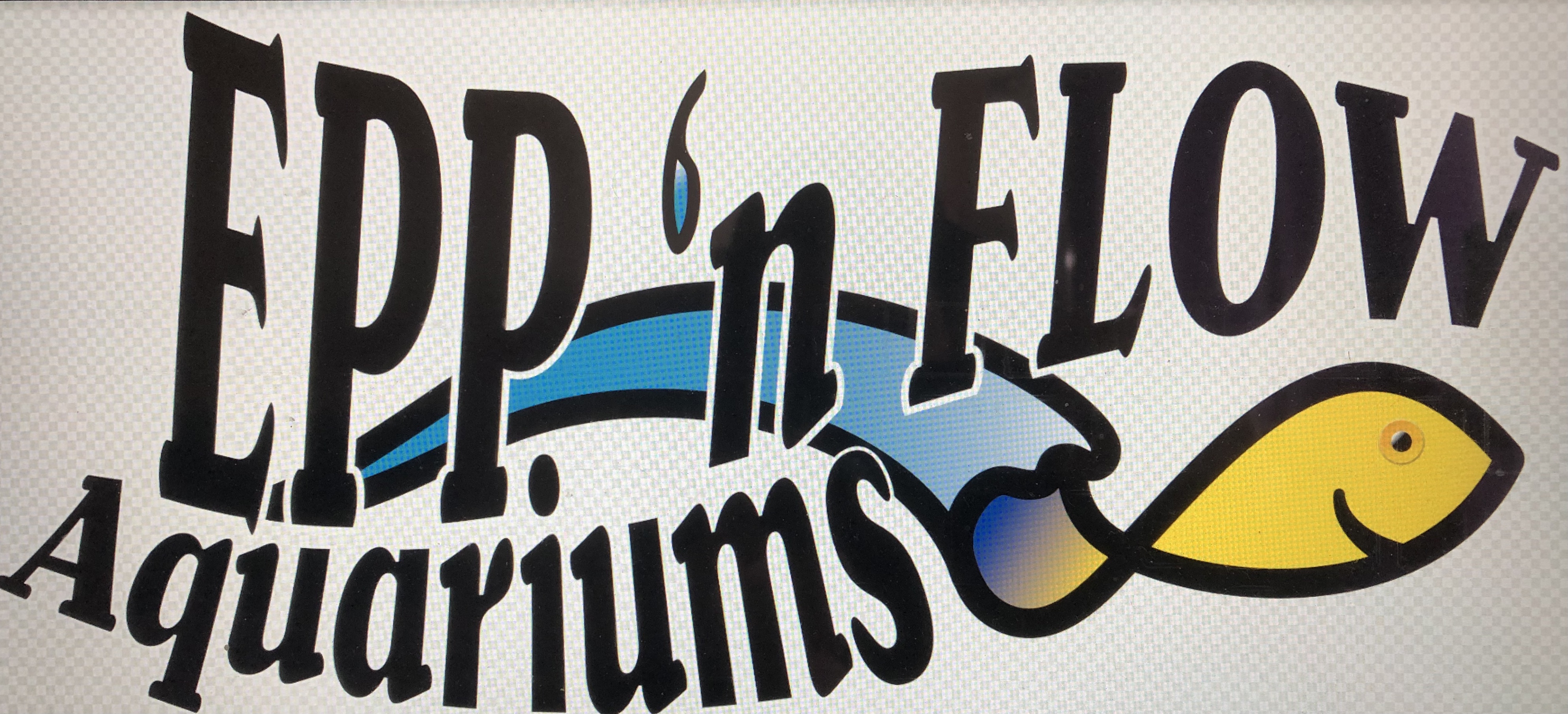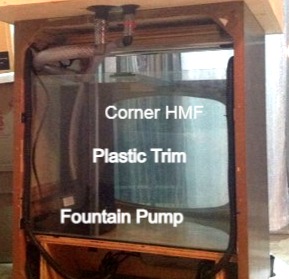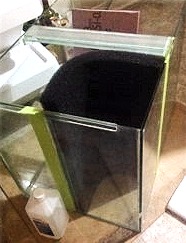The Hamburg Mattenfilter (HMF) is a FANTASTIC Aquarium FILTER Method
- Epp’nFlow Aquariums

- Jun 26, 2022
- 6 min read
Updated: Oct 20, 2024
Water Filtration
Water filtration is a key life support component of every aquarium. Common fish aquarium filtration methods include the air-driven sponge and undergravel filters, as well as motor-driven hang-on-back filters, external canister filters, and sumps. Among these options, the Hamburg Mattenfilter (HMF) method stands out due to its efficient filtration capabilities, minimal maintenance requirements, cost-effectiveness, and versatility, making it worth considering for the fishroom. The HMF is usually air-driven, and it utilizes a thick pad of foam or sponge to provide a large surface area that allows for both mechanical and biological filtration. Learn how the HMF filter works, how to maintain the HMF, and how to DIY the HMF, including 2 example builds for crafty aquarium enthusiasts.

HMF Equipment Operation

It is possible to operate this filtration method using either an air pump or an electric fountain pump to draw water through the foam wall and transfer it back across up the lift tube. Furthermore, the use of a larger centralized air pump with an air output manifold (see Example 1 ) allows the aquarist to filter multiple aquariums at the same time, efficiently and economically. Applications with fountain pumps can provide stronger flow, but require individual pumps for every aquarium, making them prone to increased maintenance.
The large surface area of the HMF foam results in very gentle filtration suitable for delicate fish and invertebrates. Additionally, the filter foam collects uneaten food, biofilm, algae, and other plants, making it an ideal grazing surface for aquarium inhabitants including livebearers, cichlids, plecos, and shrimp. Despite these benefits, the wall of HMF foam is not discrete in the aquarium. Also, the filter is installed inside the tank, reducing the aquarium swimming space. However, the resulting “false wall” can be used to hide other filtration media and equipment like heaters. To disguise the filter compartment, aquarium background or window frosting can be applied to cover the end of the aquarium. Aquarists may also use glass rods or plastic trim, to install a corner HMF to maintain viewing from all aquarium sides.
Corner Hamburg Mattenfilter installed using
90-degree plastic wall trim and silicon, and
driven by a fountain water pump.
HMF Filter Maintenance
Maintenance of the HMF requires biannual or annual squeezing of the foam wall into a sink or bucket. If the sponge is very dirty, it can be soaked and cleaned using dechlorinated water, preferably from the aquarium. Be careful not to disturb mosses and plants that may have rooted into the foam, as these are beneficial. Also, the air input at the base of the airlift tube outlet should be cleaned with an impeller brush if debris or soil granules block the outlet or air chamber (pictured below, centre/right). Retail Jetlifter tubes are designed with an air chamber cap for removal and easy cleaning. Occasionally, old check valves may also restrict airflow and require replacement. Only when the flow rate is reduced does the HMF require immediate maintenance and in some cases, the foam pad and airlift tubes can last years between cleanings, making them ideal for tanks with limited accessibility.
Mattenfilter foam after first cleaning in 3 years. DIY airlift designed with a 3/4" lift tube and 1" air chamber, sealed with two o-rings. These filters are 7 years old and still in operation.
Purchase or Do It Yourself (DIY)

Precut HMF foam and airlift tubes are available for purchase online using your aquarium dimensions. Alternatively, custom HMF assemblies can be made at home (DIY) using hardware materials to make the air lift tubers, and cutting foam sheets the width of the aquarium.
Foam Width and Porosity
Flow rate, as well as the porosity (25-50ppi) and thickness (2-3") of foam pads, can be modified to handle the aquarium bio-load and application. The thicker the foam, the easier stands upright on its own. However, the finer the porosity, the slower the water can flow through the foam.
Tips for selecting and modifying your foam to fit your aquarium:
It is recommended to use foam at least 2" or 5cm thick to ensure it stays upright underwater.
Make sure you cut the foam slightly larger than the inside dimensions of the aquarium. This will ensure a tight fit, as the foam will compress and hold itself in place. This will also keep small critters from sliding between the foam and the glass.
Sheets of foam can be attached to each other with a couple beads of aquarium-safe silicone sealant. Be sure to allow 24hrs for the sealant to cure before exposing to water.
Porosity: 25ppi (course, large holes), 35ppi (moderate, medium holes), 50ppi (fine, small holes)
Some example applications:
Example 1: Fry tanks and shrimp tanks can be fitted with a single 2" sheet of foam with a fine or medium porosity (up to 50ppi). Alternatively 1" of 35ppi can be glued to 1" of 50ppi foam with aquarium-safe silicone sealant to create a wall that may last longer between cleanings.
Example 2: The average aquarium can be fitted with a single 2" sheet of foam with medium porosity (35ppi).
Example 3: Larger fish will need course foam (25ppi) of moderate thickness (3-4") to maintain flow rate in sumps and to provide a high surface area necessary for biological filtration.
Example 4: In a sump, foam sheets should be used in a strategic order from course (25ppi) to moderate (35ppi) to fine (50ppi) porosity in order to optimize mechanical filtration.
Approximate Cost
Budget approximately $35 if you buy retail kits with precut Poret foam and Jetlifters, or approximately $20-$25 for purchasing thick filter foam and lift tube PVC building materials, for each HMF required, depending on size. Air pumps can range in price from $20 (2 outlets) to $150 (20 outlets) depending on the application; control valves and airline may cost another $10 to $50.
Two Easy HMF Filter Applications
Example 1: Filtering Multiple Aquariums on a Rack
This HMF system was built for 10 aquariums, ranging from 20 to 29 gallons. In this application, the filter choice allows for aquariums to be flush against each other and against the walls in the corner of the room.
Foam pads of 5cm (2") thickness and medium porosity were cut to size, to either 12.5x18” or 12.5x12” to fit the aquarium width and height. Additional biomedia and heaters were hidden from view behind the filter foam wall. Two PVC airlift tube designs were used: one, with an air chamber design (Venturi water lift) for tall filters (18”), and two, a “direct injection” version with a single air input for short filters (12”). In this application, a 4” glass substrate barrier was installed to designate the filter compartment at one end of the aquarium. All 10 aquarium filters, and other accessories, are supplied by a large air pump that uses 6 watts.
Air Lift Tube Designs (2):
Super Air Lift Tube (similar to a JetLifter) with air chamber and Venturi water lift:

Direct Injection Air Lift Tube

Installation Video
A short video shows the installation of a DIY Hamburg Mattenfilter into a 20-gallon aquarium.
Example 2: Sponge Filter Modified into HMF for Nano Aquariums
This Hamburg Mattenfilter system was built for 2, 2.5-gallon aquariums. In this application, the installation had a height restriction that did not allow for hang-on-back power filters. These tanks were previously filtered by single sponge filters, which were upgraded to HMF with some simple modifications.

First, an extension tube was added to the filter outlet using rigid tubing (OD 11/16"). Second, foam pads of 2.5cm (1") thickness and medium porosity (40ppi; pores per inch) were cut to size to fit the aquariums. Third, a hole is cut in the foam to accommodate the extended filter outlet. The manufactured sponge filter airlift tube design resembles the “direct injection” method, with an air inlet at the base of the upright tube. The 2 filters were further modified by adding ridged airline tubing and air control valves. In this example, the 2 filters are supplied by a single air pump that uses 2 watts.

HMF Summary
The Hamburg Mattenfilter is a functional and versatile filtration system that is well-suited for aquarium hobbyists, as it is a proven method used in fish and invertebrate breeding operations, and livestock wholesale. The minimal maintenance requirements make it ideal for the aquarium enthusiast who would rather watch their fish than clean the filter!























Commentaires